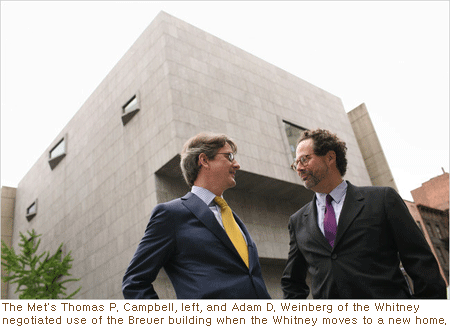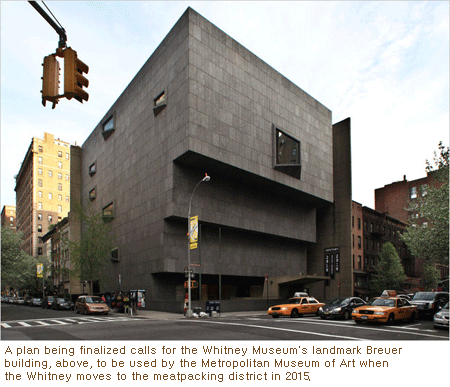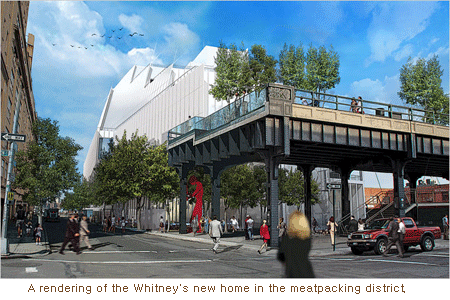Met Plans to Occupy the Whitney’s Uptown SiteThe Metropolitan Museum of Art will take over the Whitney Museum of American Art’s Marcel Breuer building in 2015, when the Whitney opens its new museum in Manhattan’s meatpacking district, according to the terms of a real estate agreement that the museum boards are pursuing.

The Breuer building’s Brutalist concrete architecture may seem like an odd fit with the stately Classical aura of the Met. But the agreement would serve both institutions: allowing the Whitney to preserve the landmark Breuer building, at Madison and 75th Street, while providing the Met with much needed space to showcase its modern and contemporary art, an area where the institution’s holdings have long been considered its weakest link.
The Whitney had been talking to several nonprofit institutions about the possibility of taking over its uptown site because it realized it cannot afford to run two museums. Under the agreement the Met will occupy the Breuer building for at least eight years.
Under the Whitney, the Breuer building has been primarily a home for American art, but officials at the Met said they would use it as an outpost for modern and contemporary art from around the globe.

While the broad brushstrokes of the deal are set, many details are still to be hammered out, officials at the museums said. Under the broad terms approved Tuesday and Wednesday by the museum boards, the Met would move into the Madison Avenue building in four years, when the Whitney’s new museum is scheduled to open on Gansevoort Street.
With the Whitney’s groundbreaking less than two weeks away, it can proceed with its plans knowing that its financial obligations have been greatly eased. “This will give us a chance to catch our breath and get some perspective,” said Adam D. Weinberg, director of the Whitney. The Met-Whitney agreement is the second major real estate development in the New York museum world this week. The Museum of Modern Art agreed on Tuesday to take over the American Folk Art Museum’s new building on West 53rd Street because the folk museum has serious financial problems. MoMA, however, will be purchasing that building, unlike the Met, which will be operating, but not buying, the Breuer building.
The prospect of running two expensive museums in two different parts of the city had weighed heavily on the Whitney’s leadership. As things stand, the museum has been working hard to pay for the downtown site, a striking 200,000-square-foot metal-clad structure by the Italian architect Renzo Piano. So far the Whitney has raised about $500 million of the $720 million for the project, a figure that includes the cost of the construction as well as an endowment, officials there said.
The projected operating costs of the new Whitney have not been disclosed, but given the building’s size, it is anticipated that those would increase.
The additional space should help the Met deflect criticism that it has long been out of touch with what’s happening in contemporary art and has weaker holdings than expected in an institution of its stature. The Met plans to renovate its modern and contemporary art galleries, and the Whitney’s six-floor building will give the Met the space to show parts of its collections on Madison Avenue, only a few blocks from the main museum on Fifth Avenue, and the opportunity to present exhibitions that it has not had room to do.
While the Met is in residence in the Breuer building, the two institutions also plan to collaborate on collection sharing, publications and educational activities, but the extent and depth of such collaborations are not set.
Although the Cloisters — its branch for medieval art in Fort Tryon Park in northern Manhattan — has been part of the Met since the 1930s, Thomas P. Campbell, its director, called this second expansion into the Whitney-owned space “a historic collaboration.”
“We’re not taking modern and contemporary art out of our main building,” Mr. Campbell said, explaining that the Met is able to show only a fraction of its holdings, which the department of 19th-century, modern and contemporary art numbers at more than 10,000 works, not including drawings and prints or photography.

“I see the Breuer building as a laboratory, a place where we can be more creative in our programming without physical limitations,” Mr. Campbell added. “This gives us the opportunity to work across department boundaries to do what other museums cannot.”
Because of its vast holdings, Mr. Campbell said, he envisions presenting contemporary and modern art in a historical context, exploring subjects and ideas culled from different centuries, countries, cultures and sensibilities.
The deal has been a long time coming. Talks began in 2008, when Leonard A. Lauder, the Whitney’s chairman emeritus, met for lunch with Philippe de Montebello, then the Met’s director, and broached the subject of a possible partnership. Mr. Campbell took up the discussion after he became director.
It is not the first time the two institutions have contemplated joining forces. Briefly, in 1947, the Met and the Whitney agreed that they would merge, with the Whitney’s collection joining an expanded American wing at the Met. But the arrangement never materialized.
Whitney officials have over the years considered selling or renting the Breuer building to a retail establishment or other commercial entity. But any plans in this direction were scrapped in 2008 when Mr. Lauder gave the museum $131 million, the largest donation in its history. Concerned about the future of the Breuer building, which he believes is the Whitney’s spiritual home and its architectural identity, Mr. Lauder placed the stipulation on his gift that that building could not be sold for the foreseeable future.
Although the financial details of the Met-Whitney arrangement have not been disclosed — or finalized — officials expect that the Met will take over the cost of operating the Breuer building, which is estimated to be about $3 million a year, and share additional revenue with the Whitney. Meanwhile the Whitney will retain use of some space in the building for art storage.
Three site-specific works designed for the Breuer building will stay intact, including Charles Simond’s “Dwellings,” a diminutive sculpture in three parts that resembles an architectural ruin. One part is nestled in a stairway landing; the other two are on the exterior of a former bank building across the street.
Under the agreement, the Met will have the option to renew its arrangement in 2023, if the Whitney agrees. But that is years away and will come when the Met is expected to have completed the renovations to its modern and contemporary art galleries.
“There is still a possibility that the Whitney will be a two-site museum,” Mr. Weinberg said.
But the Whitney also has an option to expand its downtown site, too, since it has the right of first offer on a city-owned property just north of it.
But, Mr. Weinberg said, “I’m leaving all these options open for the next generation.”


